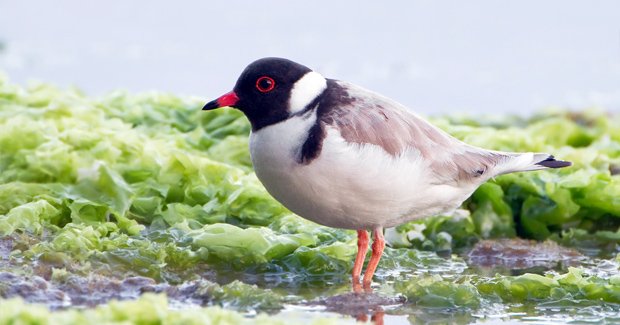Spotting the beach-loving hooded plover

AS SUNLOVERS FLOCK to the beach this summer, they would be wise to keep an eye out for the local `hoodies’.
The hooded plover (Thinornis rubricollis rubricollis) – or hoodie as it is affectionately known – not only has a nickname in common with the popular casual jacket, but also boasts a passionate band of followers.
Standing 23cm tall, the beach birds, often seen running down to the wave edge to find food, are critically endangered in southern New South Wales and listed as vulnerable in Victoria and South Australia.
Threats to the beach-going hooded plover
Human feet and dogs pose the biggest threats to the hoodie, especially during the breeding season, which unfortunately for the bird occurs when southern Australian beaches are swamped with holidaymakers over the warmer months.
Beachgoers unwittingly stand on the beautifully camouflaged eggs and chicks, while unrestrained dogs chase and frighten parents away from their nests leaving the young exposed to predators and the weather.
The plight of the hoodie has led beachside residents such as Julie Riley to become a `Friend of the Hooded Plover’ – a long-running program by conservation body Birds Australia.
A dog-lover who knew “nothing about birds” before joining the fight, Julie is one of a band of just five volunteers who have adopted several breeding pairs along the beaches near the small community of Breamlea in Victoria.
They monitor the birds, put up signs to alert beachgoers of the nesting sites and walk up and down the beach in the breeding season to talk to holidaymakers about how they can help the birds by keeping dogs on leads.
Ironically, an obedient 13-year-old dog called Zac is also part of the program at Breamlea.
“Zac is my poster boy. It is so much easier when you have a dog to approach other dog-lovers on the beach,” Julie says. “People are converted if you can point out the plovers and if you can show them chicks as well then they’re (really) sold.”
Nesting birds disturbed by beach-goers
At last count there were 1200 hooded plovers in NSW, South Australia and Victoria and while the numbers have been improving in many areas, Dr Grainne Maguire from Birds Australia says that the nation’s love affair with the coast remains the toughest challenge.
“The main challenge is people. Trying to educate people that birds are there nesting on the beach and altering behaviour,” she says.
Restricting the number of access points to beaches is also important, especially in South Australia where vehicles are allowed onto the sand, Grainne says.
Mike Bodsworth from the Great Ocean Road Coast Committee in Victoria, which is also involved in the bird conservation effort, says despite the good community involvement, many people still don’t like being told what they can and can’t do at the beach.
“In respect to dogs, people have strong ideas about not being restricted,” Mike says.
He says the Surf Coast shire has a ‘no dog zone’ declared in the plovers’ main breeding areas, but some people ignore the signs. And while some nesting areas are fenced off to protect them from people and dogs, Mike says the plovers don’t always go back to the same site to breed.
“The chicks in the first week are the size of a cotton ball; they are gorgeous and their main defence is to crouch down behind a scrap of seaweed and people just step on them,” he says.
Saving the hooded plover
Surf Coast Shire encompasses a total land area of about 1550sq.km and includes the coastal townships of Anglesea, Aireys Inlet, Fairhaven, Jan Juc, Lorne and Torquay. The hooded plovers are here in small numbers and share the same coast as many tourists visiting the Great Ocean Road.
Healthy populations of the plovers exist in Western Australia and Tasmania and colonial records show it was also once found in Queensland but is now extinct.
They might not know it, but the plovers are also giving something back to their human shepherds.
“The bird has a massive effect on people – once they (people) start watching the birds they start following their local pair and they become part of their family,” Grainne says.
RELATED STORIES

